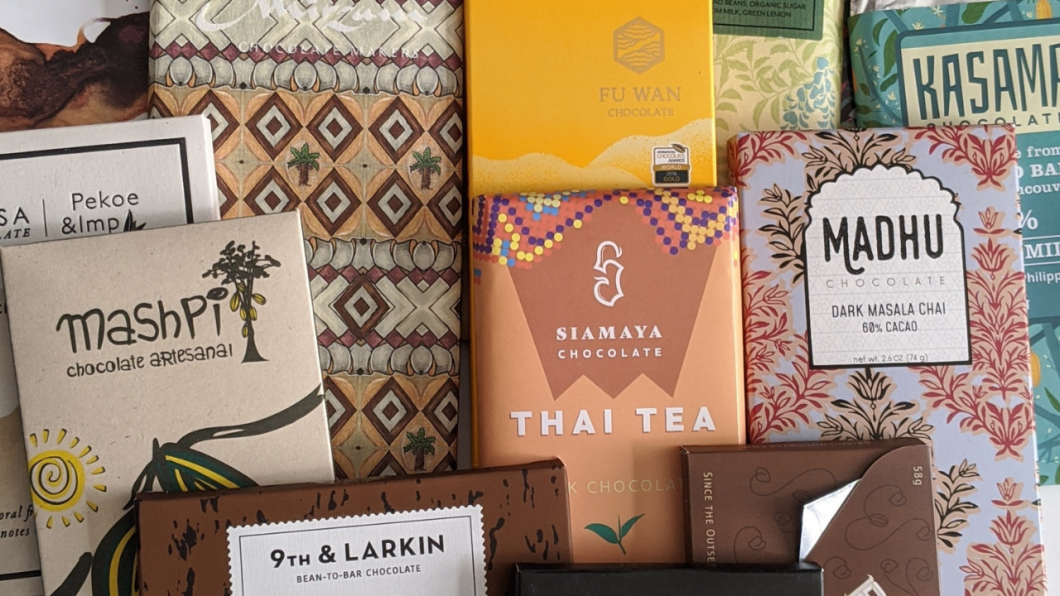Today I’m bringing you ways to save money on bean to bar chocolate. Because while bean to bar chocolate is the most ethical type of chocolate we’ve got and it’s dang awesome, it’s also generally the most expensive. So here are the ways I personally save money, and I hope they can help you out.
For supporting tips to go with this post, have a video!
Buy from a bean to bar chocolate shop in person (when possible)
Going in person to a bean to bar chocolate shop is one of the best ways to get started in bean to bar chocolate and save money. A good shop will have knowledgeable folk who can offer personalized recommendations, education, and samples, and between all three you’ll ideally leave only with the chocolate you really want. (And that’s always the best way to save money here anyway, to buy only the amount and types of chocolate you want to eat.) I will say it is really easy to leave with more chocolate than you planned though (I may speak from experience), so I’d go in with a goal and even let the staff know if need be.
There are sadly fewer bean to bar shops nowadays (RIP Chocolopolis), but in the last few years more chocolate makers have opened brick and mortars, and some even carry other brands. So I’d be looking and seeing if there’s a shop near you!
Some examples of shops I recommend (I’ll have a blog post up on this coming up):
And if you can’t go to either in person, you’re not out of luck. Most shops have some form of social media presence, including recommendations. I’d start with Bar & Cocoa, who has a pretty great blog as well as bundles.
All that being said…
Buying direct from makers can actually be a huge savings
I wouldn’t recommend making this jump unless you know what brands you already like, because to get free shipping you’re still usually committing $30-$40+ to a single brand. On the flip side, if you do know your favorites, you could save a ton of money buying direct.
First they’re all more likely to have discounts, be it flash sales, annual sales, just a lot of sales. Second, they’re just going to generally carry more of their lineup even online, like White Label’s drinking chocolate or Creo’s black sesame brittle.
And somehow many of them have ridiculously good shipping rates? There are a lot of discounted shipping rates, or $30-$45 shipping minimums. Or it just evens out to be a deal. Like Soma Chocolate, with its whopping $25 shipping to us from Toronto, is in fact a huge savings just from the price differences. (For example, one of my favorites from them, Old School Milk, is $14.50 US through Bar & Cocoa and ~$9.42 US direct. You can break even surprisingly fast.)
Mailing lists! They rock!
For both shops and makers, mailing lists are the easiest way to actually know about sales. (And in fact, many use them to announce flash sales, like Fruition and Fresco.) I used to recommend Instagram, but wow is that hard to search nowadays.
If you’re not interested in getting 10+ emails a month, which fair, most brands have their big sales at about the same times, but those won’t include the flash sales (which can be better than the big sales):
- Labor Day
- After Halloween
- Black Friday / Small Business Saturday
- After Christmas
- Valentine’s Day
Advent calendars: a great way to learn about chocolate
If you’re interested in learning a ton about a maker or makers quickly, you really can’t beat advent calendars.
I’m not talking about the ~$5-$10 ones with one flavor of chocolate. More bean to bar chocolate makers each year are offering advent calendars that are basically a sampler of their entire stock. On the flip side they’re not cheap, with the cheapest starting at ~$25 US with McGuire Chocolate and some running $200+.
I have a playlist of reviews over on Youtube of some if you’d like to hear more, but I think the best ‘bang for your buck’ advent calendar is Yahara Chocolate’s, which runs ~$50 and has mini bars from 4-5 brands, usually including Raaka, Askanya, and To’ak, so it’s a great representation of styles and flavors.
Bulk baking chocolate
I feel like it’s still pretty not well discussed how many baking options there are now in bean to bar chocolate. Which is fair, it’s actually pretty new to have so many options that aren’t Valrhona or Guittard. But they’re here and they’re awesome.
The best source for more classic couverture brands like Valrhona and Guittard is Chocosphere. The website hasn’t changed much in like 10+ years, but they rock and often have small bars available to try before plunking down $100+ for bulk chocolate.
Personally nowadays we get Fresco and White Label (through Mutari), and occasionally Marou (through Caputo’s). (Honestly we’d still be getting Valrhona, but I can taste soy lecithin now and that limits things a tad.) Fresco has a 68% Ghana blend that’s really snacky, White Label’s is a 66% and usually somehow tastes darker than Fresco’s. Marou we mainly get the 85% bulk chocolate, which comes in 15g blocks for hot chocolate. (Don’t use it for truffles, it seizes easily, but it’s great for custard.) These all cost a fair bit more per pound, starting at ~$25/pound, but we wait for sales when possible.
—
I hope these can help! I’d mix and match these tips in a way that works best for you. Because no matter what, always the best way to save money on chocolate is to buy the amount you want and can eat, and waste as little as possible. Sure there will always be some, but I like to think of that as spare hot chocolate in the making.

